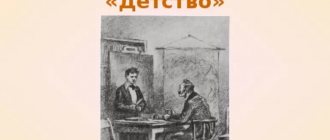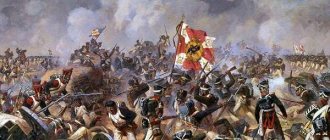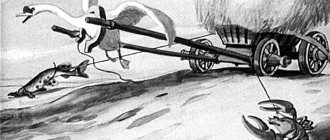Essay Eternal Art
“Art is a mirror where everyone sees themselves.”
- Goethe.
Why is art called eternal? Some works were created several thousand years ago, but people still appreciate them. For example, Homer's epic poems The Iliad and Odyssey, written around the eighth century BC, are now taught in schools. The situation is similar with Dante’s poem “The Divine Comedy”, and with Shakespeare’s tragedy “Hamlet”, and with Miguel Cervantes’ novel “The Cunning Hidalgo Don Quixote of La Mancha”, and many other masterpieces of mankind. This is an eternal art that has reached us and will certainly pass on to our descendants. The creator of real art puts his whole soul into the work, creating for centuries, and the artisan only works for money.
Will a custom-written “soulless” poem take an important place in people’s hearts? Even if it has good rhymes and perfect rhythm, it still will not stand the test of centuries and popular recognition.
In Bulgakov’s work “The Master and Margarita,” Ivan Bezdomny writes anti-religious poems to order in the same way. The master gave all of himself to his only creation without a trace. This is what attracted Margarita as a connoisseur of this art. She believed that her life was contained in the novel about Pontius Pilate, unrecognized and ridiculed. Ivan himself admits that his poems are terrible and that to write something good you need to put your soul into it. What he cannot do due to disinterest in the topics of orders. However, he does not stop “creating” for the sake of money. The master would also like to arrange his life, but art still remains in first place for him.
A similar confrontation between art and craft, the eternal and the soulless, occurs in Pushkin’s work “Mozart and Salieri.” Are you enrolling in 2019? Our team will help you save your time and nerves: we will select directions and universities (according to your preferences and expert recommendations); we will fill out applications (all you have to do is sign); we will submit applications to Russian universities (online, by e-mail, by courier); we will monitor competition lists ( we will automate the tracking and analysis of your positions); we will tell you when and where to submit the original (we will evaluate the chances and determine the best option). Entrust the routine to professionals - more details.
Salieri cannot surpass Mozart in any way, because he is a real artisan and is incapable of composing something new. Honore de Balzac said: “The main goal of art is not the empty copying of objects and objects. It should give something new, sensual, real.” In the end, Salieri kills his rival, but Mozart's death did not solve the problem. He remains a craftsman, fulfilling orders with high quality, and Mozart is still revered. His music has deservedly become a masterpiece of world classics. All because he knew how to put his soul into creativity.
A person tends to fall in love with something that can amaze and evoke real emotions. The author puts a piece of himself into such works - and this brings that very eternity. The Master and Mozart devoted themselves entirely to art, which is why their creations are recognized (even if the Master was ridiculed, Margarita began to see the meaning of life in his novel). For a true creator, nothing is more important than his brainchild.
Why is art eternal? Because it contains a piece of the soul invested by the author, along with everything that he could share and teach. Only true art is preserved through the centuries. The problems and subjects raised in their works can interest a person of any century. This is what eternal art means. Art created timelessly by a caring heart. A novel or painting created without the author’s dedication is instantly lost in the first decades.
Useful material on the topic:
- Temporary and eternal in our lives
- Do you agree with the statement: “Only a chosen one can create art, Every person can love art” (J. Grun). Arguments on the topic “Music and Art”
- Why do people confuse art and craft? How to distinguish real art from craft?
- "Art"
- REAL ART
Purposes of art
So, why does a person need art? What goals, conscious and unconscious, are pursued by people involved in art? Attempts to find and identify the goals that people pursue when engaging in art can be traced back to Antiquity. The ancient Greek philosopher Aristotle, in his work “Poetics,” highlighted the so-called “unmotivated goals of art” [Aristotle, 1998]. By this definition, Aristotle understood the natural instinct and human desire for harmony, balance and rhythm. Simply put, the desire for beauty, which exists regardless of the degree of usefulness of beauty.
Further, art allows you to connect your imagination and perceive this world without the mediation of verbal forms: see a picture, hear music, feel inspired. This component of art was pointed out by the German philosopher Immanuel Kant in his work “Critique of the Power of Judgment” [I. Kant, 1994]. The desire for imagination is characteristic of any person, which can be easily noticed when watching children. They play, fantasize, endow objects with non-existent properties, they themselves depict animals, cars, airplanes...
Somewhere next to the imagination is the human desire for mystery and mystery. Here again we can remember children and their love for fairy tales. And even if adults do not pay enough attention to reading fairy tales to children, the latter very quickly begin to come up with fairy tale plots on their own. It is interesting that such a component of the goals of art as the desire for mystery was emphasized by the famous scientist Albert Einstein, the author of the theory of relativity. In particular, he wrote about this in his work The World as I See It (“The World as I See It”) [A. Einstein, 2015].
The symbolic function of art is also directly related to the imagination. From the moment when the human imagination began to paint some otherworldly picture of the world with mythical creatures, the need arose to somehow visualize such fantasies and convey them to others.
By the way, the opportunity to address an unlimited circle of people with whom a person is unfamiliar personally, but would like to share his emotions or vision of something, is also one of the goals that people pursue when doing art. Thus, art can become a means of communication, advertising and propaganda, a means of psychotherapy and a way of expressing protest, an option for expressing one’s own views and simply entertainment.
All of the above does not mean that the goals of art have always been clear to everyone. Or at least they became clear as they were formulated into clear formulations indicating cause-and-effect relationships. The topic of the goals of art constantly became a source of discussion, and discussions on the topic “why is art needed” did not always lead to any clear answer to the question posed.
As an example, we can cite the famous work of the writer Leo Tolstoy “What is Art,” written back in 1897 [L. Tolstoy, 1897]. A significant part of the work is devoted to doubts about the benefits of art as such and the adequacy of the labor and financial costs of creating works of art.
The reason for this kind of reasoning was a completely ordinary situation for the creative community, when Leo Tolstoy had the opportunity to attend a rehearsal of a large-scale performance, where about a hundred musicians and about the same number of actors were involved, not counting the technical staff and artistic directors. There is no need to explain to people who once took part at least in amateur artistic performances that it is not easy to coordinate such a number of people, and there can be a lot of failures, and they will be followed by many showdowns, mutual dissatisfaction and countless repetitions of the practiced action.
Leo Tolstoy asked himself a sacramental question: why?!.. Or, as Tolstoy himself wrote, “what is being done here and for what and for whom?” [L. Tolstoy, 1897]. To explain his point, Tolstoy gives an example of how he happened to observe loading and unloading operations and the expression of someone’s dissatisfaction with the uncoordinated actions, which caused a heavy object to be unloaded to fall. In a loading and unloading situation, for Tolstoy the reason for dissatisfaction is understandable, because uncoordinated actions and the fall of the unloaded item can lead to breakdown. But the writer Leo Tolstoy does not understand what such a terrible thing will happen if the actors do not appear synchronized enough, or the musicians play a little faster than required.
The next ten pages are devoted to an analysis of what various scientists, philosophers and representatives of other creative professions said about art at different times. Leo Tolstoy comes to the conclusion that, even if we agree that the goal of art is the desire for beauty, there is still no unambiguous definition of what beauty is [L. Tolstoy, 1897].
Moreover, Leo Tolstoy believes that one cannot limit the understanding of art to the desire for beauty, and gives his own definition of art: as soon as the audience, the listeners, are infected with the same feeling that the writer experienced, this is art [L. Tolstoy, 1897]. Feelings can be very different, and they are not always beautiful and wonderful. Emotions can also be different, and not always positive. Here we can quite agree with this understanding of art.
What are Tolstoy’s main “claims” to art? In short, the writer believes that art alienates people from nature, the so-called natural conditions of life. And not even art itself, but the forms that it acquired in Leo Tolstoy’s contemporary society. Tolstoy believes that in his contemporary world, the “ideal of morality has been replaced by the ideal of beauty,” and art in its existing form corrupts people [L. Tolstoy, 1897]. Let us once again draw your attention to the fact that the essay was written by Leo Tolstoy in 1897, and what he would have written if he had seen examples of art of the 21st century, one can only guess...
At the same time, Tolstoy believes that, we quote: “art is one of the two organs of human progress. Through the word a person communicates with thought, through images of art he communicates with feeling with all people not only of the present, but of the past and the future.” The problem, in his understanding, is only that the art forms have taken on a perverted appearance.
He considers perversions, in particular, huge labor costs to create works of art - printing “sham art” books, preparing low-grade theatrical productions. Tolstoy returns to this idea several times throughout his essay “What is Art.” True, we will not find a clear answer from Tolstoy about who to trust and how to determine the artistic value of a work of art.
And most importantly, any claims to art or to the forms in which it exists only confirm the previously stated theses: people cannot do without art, and art cannot exist outside of any form or type. This means that people can only improve art forms and invent new ones, which may someday become better than what we have seen so far.
And one more conclusion that arises after getting acquainted with the entire array of thoughts of great people about art: art cannot be reduced solely to usefulness. Initially, Aristotle was right in his work “Poetics” when he identified the so-called “unmotivated goals of art” and explained that a person’s desire for beauty exists, regardless of the degree of usefulness of beauty [Aristotle, 1998].
This postulate is also relevant in the coming third millennium. As confirmation, we cite the lecture “What is Art” by the British musician and composer Brian Eno, given by him as part of the annual John Peel lecture series in 2015 [B. Eno, 2015].
For reference: John Peel is a British radio presenter who recorded radio concerts of many once unknown musicians and bands of the 60s, 70s, and 80s, which contributed to the rise of their popularity. Nowadays, John Peel is a recognized expert in the world of modern music, able to “balance between things that you know people like and things that you think people might like.”
So, while preparing his lecture, Brian Eno wondered where the concept of “creative industry” came from. And it appeared due to the desire of many creative projects to receive government funding. It is easier to obtain government funding if it is possible to demonstrate the usefulness of the project in numbers, including in economic terms such as “industry.”
According to Brian Eno, this approach is “the beginning of the end for art, because it allows you to think that what cannot be expressed in numbers is useless” [B. Eno, 2015]. However, reducing art to momentary current figures is essentially wrong, because art and creativity develop human imagination, without which a person would not be able to make scientific discoveries or imagine future technical and design projects. Yes, even just to understand other people, because to do this you need to be able to imagine yourself, as they say, “in their shoes.”
The latter, by the way, is very important and relevant. Man is a social being, and for a full life he needs emotions no less than science, knowledge and achievements of scientific and technological progress. So art in the broadest sense of the word - music, theater, books, television series, etc. - makes it possible to experience a wide variety of emotions in safe circumstances.
This is a common property of all art, regardless of its “nationality”. In relation to our subculture, we can say that we do not have to throw ourselves under a train, like Anna Karenina, or drown a defenseless dog, like Gerasim. We can experience the emotions that the characters experienced simply by reading works of art.
But for this, our subculture must have works of art of such a level that evoke powerful emotions. And this would be impossible if art and culture were developed solely for reasons of utility, expressed in income, profit or the number of jobs created. We need art regardless of this whole list of “useful things”.
But let’s return to the question posed in the title of the article: what exactly is art? Yes, we tried to answer it in our Art History course, but we can agree with the definition proposed by Brian Eno. He believes that art is something that a person should not do, but does anyway.
A person must eat to get nutrients, but getting nutrients doesn't require fancy meals and table settings. A person must dress to avoid freezing, but any clothing protects against the cold, and it does not have to be fashionable and beautiful. And the ax of a primitive man is always an ax, regardless of whether the person bothered to put some kind of pattern on the ax handle.
And how to determine how many and what emotions each of us needs to live a full life? And in what format do we need these emotions? In the form of a concert of classical music or a rock concert, in the form of impressionist paintings or a photo report on a trip to the Himalayas, in the form of a film adaptation of the novel “War and Peace” or another television series?
The answer will be different for everyone, and that is why society needs art, even if at some stage of development it does not clearly understand what should be understood by art.
We also recommend reading:
- Storytelling
- Vygotsky's concepts: contemporary relevance and actual modernity
- 7 liberal arts: from Antiquity to the present day
- Holland's theory of six personality types
- How art affects the human psyche: a brief educational program
- Norms and rules of morality
- Modern and postmodern in the culture of the 20th century
- Modernism vs Postmodernism: can they be compared?
- Stendhal syndrome
- Ways to Learn to Appreciate Art
- Conceptualism: from the Middle Ages to the present day
Key words: 1Cognitive science, 1Self-knowledge








